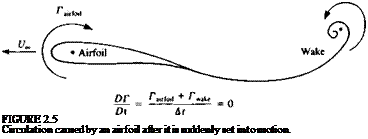RATE OF CHANGE OF CIRCULATION: KELVIN’S THEOREM
Consider the circulation around a fluid curve (which always passes through the same fluid particles) in an incompressible inviscid flow with conservative body
forces acting. The time rate of change of the circulation of this fluid curve C is given as
Since C is a fluid curve, we have
and therefore
![]()
![]() (2.14)
(2.14)
since the closed integral of an exact differential that is a function of the coordinates and time only is <J>C q • dq = <J>C d(q2/2) = 0. The acceleration a is obtained from the Euler equation (Eq. (1.62)) and is
—v(£)+r
Substitution into Eq. (2.14) yields the result that the circulation of a fluid curve remains constant:
 |
since the integral of a perfect differential around a closed path is zero and the work done by a conservative force around a closed path is also zero. The result in Eq. (2.15) is a form of angular momentum conservation and is known as Kelvin’s theorem (after the British scientist who published his theorem in 1869), which states that: the time rate of change of circulation around a closed curve consisting of the same fluid elements is zero. For example, consider an airfoil as in Fig. 2.5, which prior to t = 0 was at rest and then at f>0 was suddenly set into a constant forward motion. As the airfoil moves through the
fluid a circulation rairfoii develops around it. In order to comply with Kelvin’s theorem a starting vortex Twake must exist such that the total circulation around a line that surrounds both the airfoil and the wake remains unchanged:
^ P ^airfoil "1" Pvake 1Л
d7“ Ї,————– “° (116)
This is possible only if the starting vortex circulation will be equal to the airfoil’s circulation, but its rotation will be in the opposite direction.











